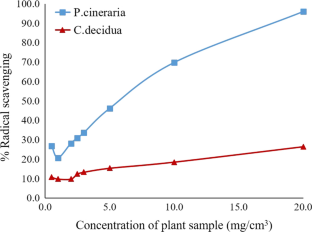Comparative Antioxidant potential of two drought resistant medicinal plants of Rajasthan: Prosopis cineraria and Capparis decidua
Research Articles | Published: 01 February, 2021
First Page: 229
Last Page: 234
Views: 3828
Keywords: Antioxidant, Prosopis cineraria , Capparis decidua , DPPH, FRAP
Abstract
The aim of this study was to assess and compare the antioxidant potential and total phenolic content of ethanolic and aqueous extracts of the fruits of Prosopis cineraria and Capparis decidua. Free radical scavenging activity of the extracts in the concentration range 0.5–40.0 mg/cm3 was determined by DPPH (2.2-diphenyl-1-picrylhydrazyl) assay using BHT as a standard. IC50 values for the ethanolic and aq. extracts of P. cineraria (7.026 ± 0.088 mg/cm3 and 4.097 ± 0.033 mg/cm3) were found to be significantly (p ≤ 0.05) lower than the corresponding extracts of C. decidua (47.538 ± 0.040 mg/cm3 and 14.066 ± 0.039 mg/cm3). Total phenolic content for the aq. extract of P. cineraria (3.512 ± 0.013 mg GAE/g) was significantly (p ≤ 0.05) higher than aq. extract of C.decidua (2.142 ± 0.032 mg GAE/g), whereas the ethanolic extracts of the two plants did not show any significant difference in their phenolic content. The FRAP value for the aq. extract of P. cineraria (17.951 ± 0.026 mg Fe(II) eqv/g) and C. decidua (21.343 ± 0.009 mg Fe(II) eqv/g) was significantly (p ≤ 0.05) higher than their corresponding ethanolic extracts (2.742 ± 0.023 and 2.313 ± 0.020 mg Fe (II) eqv/g). The reducing capacity by ferrozine assay for the ethanolic and aq. extracts of P. cineraria (4.767 ± 0.4877 and 10.370 ± 0.005 mg AE/g) were significantly (p ≤ 0.05) higher as compared to the ethanolic and aqueous extracts of C. decidua (0.160 ± 0.136 and 1.537 ± 0.046 mg AE/g).

References
- Ac M, Sanders R, Watkins J (2003) Diabetes, oxidative stress, and antioxidants : a review. J Biochem Mol Toxicol 17:24–38
- Benzie I, Strain J (1996) The ferric reducing ability of plasma (FRAP) as a measure of “antioxidant power” : the FRAP assay. Anal Biochem 239:70–76
- Bharadwaj C, Shetty P (2019) In-vitro Antioxidant and free radical scavenigng activity of Leucas indica and Alternanthera tenella. J Emerg Technol Innov Res 6(4):418–424
- Blois MS (1958) Antioxidant determinations by the use of a stable free radical. Nature 181:1199–1200
- Chogem S, Pasiecznik N, Harvey M, Wright J, Awan S, Harris P (2007) Prosopis pods as human food, with special reference to Kenya. Water SA 33:419–424
- Grice HC (1986) Safety evaluation of butylated hydroxy toluene (BHT) in the liver, lung and the gastrointestinal tract. Food Chem Toxicol 24:1127–1130
- Joseph B, Jini D (2011) A medicinal potency of Capparis decidua—a harsh terrian plant. Res J Phytochem 5:1–13
- Kadriye BI, Guclu K, Apak R, Demirata B (2010) A novel antioxidant assay of ferric reducing capacity measuremnet using ferrozine as the colour forming complexation reagent. Anal Methods 2:1770–1778
- Khandelwal P, AvatarS R, Agarwal M (2015) Pharmacology, phytochemistry and therapeutic application of Prosopis cinerarialinn: a review. J Plant Sci 3:33–39
- Malik S, Mann S, Gupta D, Gupta RK (2013) Nutraceutical properties of Prosopis cineraria (L.) druce pods: a component of “Panchkuta.” J Pharmacogn Phytochem 2:66–73
- Miranda C, Rodrigues F, Shetty P (2019) Antioxidant Capacity and free radical scavenigng activity of Pterocarpus marsupium and Vitis vinifera by using different in vitro model—a comparative study. J Emerg Technol Innov Res 6(5):578–585
- Muhammad ZUH, Sanja C, Mughal Q, Imran I, de Vincenzo F (2011) Compositional studies: antioxidant and antidiabetic activities of Capparis decidua (Forsk.) Edgew. Int J Mol Sci 12:8846–8861
- Nurhanan AR, Wan Rosli WI, Mohsin SSJ (2012) Total Polyphenol content and free radical scavenging activity of Cornsilk (Zea mays hairs). Sains Malays 41(10):1217–1221
- Pandey AN, Rokad M (1992) Sand dune stabilization: an investigation in the Thar desert of India. J Arid Environ 22:287–292
- Pareek AK, Garg S, Kumar M, Yadav S (2015) Prosopis cineraria: a gift of nature for Pharmacy. Int J Pharm Sci 6:958–964
- Prieto P, Pineda M, Anguliar M (1999) Spectrophotometric quantification of antioxidant capacity through the formation of a phosphomolybdenum complex : specific application to the determination of Vitamin E. Anal Biochem 269:337–341
- Purohit A, Vyas K (2005) Hypolipidemic efficacy of Capparis decidua fruit and shoot extracts in cholestrol fed rabbits. Indian J Exp Biol 43:863–866
- Rani B, Singh U, Sharma R, Gupta A, Dhawan N, Sharma A, Maheshwari R (2013) Prosopis cineraria (L) druce: a desert tree to brace livelihood in Rajasthan. Asian J Pharmaceut Res Health Care 5:58
- Rathee S, Mogla O, Sardana S, Vats M, Rathee P (2010) Antidiabetic activity of Capparis decidua Forsk Edgew. J Pharm Res 3:231–234
- Sherikar AS, Mahanthesh MS (2015) Evaluation of aqueous and methanolic extract of leaves of Epipremnum aureum for radical scavenging activity by DPPH Method, total phenolic content, reducing capacity assay and FRAP assay. J Pharmacogn Phytochem 4(4):36–40
- Singleton VL, Rossi JA (1965) Colorimetry of total phenolics with phosphomolybdic-phosphotungstic acid reagents. Am J Enol Vitic 16:144–158
Author Information
Department of Chemistry, Sophia College (Autonomous), Mumbai, India